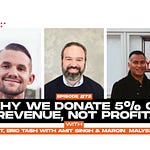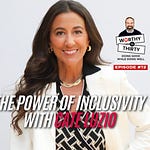🎙️ Purpose-Driven Profits: The ANDI Brand’s Blueprint for Doing Good While Doing Well
🚀 Introduction
Welcome back to the Worthy for Thirty podcast. If this is your first time here, welcome! I am your host, Eric Tash.
We talk a lot about scaling, funding, and product-market fit, but what about the core “why” that truly sustains a business through the inevitable challenges? Today, we’re diving deep into the story of a brand that defines doing good while doing well: The ANDI Brand, founded by Andrea Weinberg.
The ANDI Brand isn’t just about beautifully designed, functional bags; it’s a masterclass in purposeful iteration and building a company on the bedrock of human connection and sustainability.
Andrea’s journey, spanning over a decade, offers concrete lessons on how to stop chasing fleeting trends and instead, focus on creating products that truly serve a purpose and last. If you’re wrestling with balancing your mission with your bottom line, this episode is your blueprint.
I. The Birth of a Purpose: Chasing Adventure, Not Immediate ROI
The Problem/Opportunity: Andrea didn’t start with a spreadsheet; she started with a desire to create a genuinely purposeful product. Her goal was to design for adventure and functionality. Versatility meets fashionable, meets durability. (Say that 3x fast).
Actionable Insight for Founders: A key piece of advice from her mentors was not to expect immediate financial success. This reframed her journey from a sprint to a marathon of exploration.
Case Study Connection: This echoes the early days of Patagonia. Founder Yvon Chouinard initially focused on making the absolute best climbing gear, driven by a passion for the environment, allowing purpose and quality to lead the way before aggressive scaling.
The First Hurdle (Actionable Challenge): Finding a manufacturing partner who would collaborate on a novel vision, like her initial waterproof handbag, required persistence. Andrea’s takeaway: Don’t be afraid to knock on 100 doors; you only need one to open.
II. The Discipline of Purposeful Iteration: Quality as the Core Mission
The ANDI Brand Example: The signature tote bag went through 68 iterations over 10 years. This is the non-glamorous, high-discipline work that underpins “doing well.”
Actionable Insight: Prototype to Learn, Not to Launch. Since Andrea didn’t know design, she used tactile experimentation (e.g., duct tape prototypes) to immediately translate her functional vision into a tangible object. This allowed her to get physical feedback from potential users and manufacturers long before committing to a final design. For non-designer founders, your prototype is your most essential research tool.
The Founder’s Advantage: A lack of formal training often comes with a lack of preconceived suggestions. Andrea was free to approach factories with a unique, user-driven concept rather than being held back by traditional industry practices or design dogma. Your “outsider” perspective can be a powerful source of innovation if you validate it relentlessly through iteration. Reminds me of my conversation with Marcin & Amit at Mission Craft Cocktails :).
The Tension Point: Andrea’s belief is crucial: Mission matters, but quality is the core. If your product doesn’t meet a need effectively, the mission is irrelevant to the customer.
Case Study Connection: Think of Tesla’s early focus. Their mission is sustainability, but the reason people buy the cars is because they are high-performance, quality vehicles. Quality validates the mission. Founders, never let your mission be an excuse for a mediocre product.
III. Human Connection: Your Most Valuable Business Asset
The Counterintuitive Insight: Andrea emphasizes overcoming the fear of reaching out. Meaningful collaborations and opportunities often come from unexpected places—from a cold email to a chance encounter.
Real-World Example: Andrea’s year of “van life” reinforced the profound insights and enriching relationships that come from engaging with strangers. This translates directly into market research and authentic brand building.
Actionable Tip: Schedule “Reach Out” time. Make a list of three people you admire (mentors, potential partners, customers) and send them a brief, thoughtful email or LinkedIn message this week.
Case Study Connection: This aligns with the “Community First” models of brands like Lululemon (building a brand through yoga instructors and ambassadors) or Airtable (growing by empowering individual users and developers to evangelize the product). Your network is your advisory board and your early market.
IV. The Sustainability Pivot: From Afterthought to Cornerstone
The Evolution: Sustainability was not her primary focus at the start. It became a non-negotiable commitment as she recognized the environmental impacts of consumerism.
The Mission Alignment: The philosophy of “doing more with less” became central. This translates into products designed for longevity and versatility, fighting fast fashion/disposable culture.
The Deeper Dive: Her commitment deepened through collaborations with scientists and a focus on textile waste and upcycling. Sustainability is now a source of innovation, not just a cost center.
Case Study Connection: Look at Allbirds. They didn’t just use one sustainable material; they made sustainable innovation their core differentiator (wool, eucalyptus, sugarcane) to disrupt a massive industry. How can your mission drive radical innovation in your product?
V. Navigating Uncertainty: The COVID Re-evaluation
The Challenge: Like many founders, Andrea faced significant shifts like consignment deals, supply chain shocks, and the pandemic. She had to pivot quickly without losing sight of the business and its objective of producing a great, long-lasting product that can be used for multiple occasions.
The Actionable Response: The period of uncertainty forced her to step back and re-focus on the brand’s core mission and the evolving needs of her customers. This wasn’t a time for panic; it was a time for strategic recalibration.
Key Takeaway: Adversity doesn’t define your mission; it tests it. If your purpose is genuine, it provides the North Star needed to pivot successfully.
🎯 Conclusion & Key Takeaways
The journey of Andrea Weinberg and the ANDI Brand offers compelling and actionable lessons for every founder: The path to doing good is the path to doing well, but it demands discipline, connection, and a relentless focus on quality.
Here are the Three Core Action Items to implement this week:
Embrace Iteration: Don’t chase perfection; embrace continuous improvement. What is the “duct tape prototype” you can build today?
Activate Your Network: Reach out to someone you admire or a potential collaborator. Human connections are your cheapest and most valuable growth hack.
Validate Your Mission with Quality: Ensure your product’s performance is so exceptional that your mission becomes the bonus.









